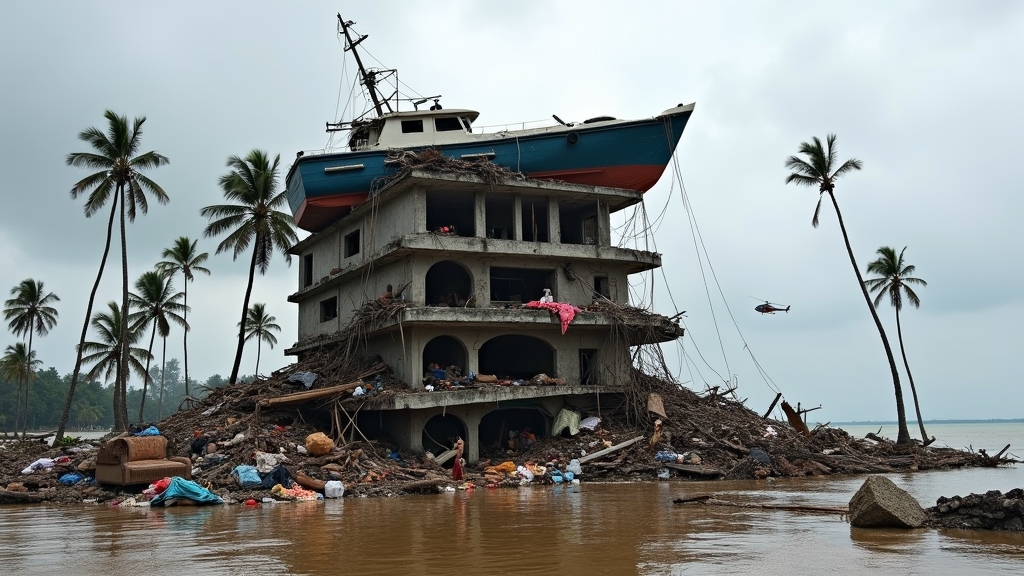The 2004 Indian Ocean earthquake and tsunami devastated coastal communities across fourteen nations, resulting in over 230,000 deaths and $10 billion in economic damage. The 9.1-9.3 magnitude quake struck off northern Sumatra on December 26, generating 30-meter waves that reached speeds of 80 kilometers per hour and traveled up to 6 kilometers inland.
While Indonesia suffered the heaviest losses with 167,000 casualties, the catastrophe sparked an unmatched $14 billion international aid response that would reshape disaster preparedness worldwide.
The Devastating Earthquake That Triggered a Catastrophe
On the morning of December 26, 2004, one of history’s most powerful earthquakes struck beneath the Indian Ocean, releasing a catastrophic chain of events that would reshape coastlines and devastate communities across multiple continents.
The massive 9.1-9.3 magnitude earthquake originated 30 kilometers beneath the seabed off northern Sumatra’s west coast, generating unprecedented seismic forces that violently displaced the ocean floor. The rupture created a massive fault line extending 1,300 kilometers long, forever altering the region’s geological landscape.
The tremendous energy release triggered catastrophic movements across the Indian Ocean, setting into motion powerful tsunami waves that would travel at speeds up to 80 kilometers per hour.
These waves, which would eventually reach heights of 30 meters, began their deadly march across the ocean, taking between 15 and 90 minutes between successive waves as they approached vulnerable coastal regions.
Understanding the Tsunami’s Deadly Path
The devastating force of the earthquake manifested in a complex tectonic interplay between the Indian and Burma plates, setting up the conditions for one of history’s deadliest tsunamis. The rupture of approximately 1,600 kilometers of fault surface generated massive waves that would wreak havoc across multiple nations and continents.
The tsunami‘s destructive path extended over 800 kilometers of shoreline, obliterating coastal communities from Indonesia to Thailand, Sri Lanka, and beyond. In many areas, the waves left no structures standing, and their remarkable reach extended as far as Africa’s eastern coast. The impact was particularly severe in Aceh Province, where waves reached up to 6 km inland.
The absence of adequate warning systems compounded the tragedy, as communities had little time to evacuate or prepare for the incoming waves, leading to catastrophic losses of life and infrastructure across the Indian Ocean basin.
The Human Cost Across Nations
The devastating waves ended up claiming over 230,000 lives across fourteen nations.
Indonesia bore the brunt of the catastrophe, with more than 167,000 people dead or missing, while Sri Lanka and India suffered staggering losses exceeding 53,000 combined.
The tragedy’s reach extended far beyond local populations, claiming thousands of international tourists, particularly in Thailand’s coastal resorts, where visitors from Sweden, Germany, and other European nations perished.
The disaster’s toll fell heaviest on society’s most vulnerable members, leaving over 1.7 million people displaced and thousands of children orphaned, while destroyed infrastructure and political instability in certain regions complicated relief efforts.
The extensive damage included over 200 boats sunk in France’s Réunion territory, demonstrating the tsunami’s far-reaching impact.
Environmental and Physical Destruction
The tsunami’s impact on infrastructure proved catastrophic, with up to 70% of shoreline buildings suffering significant damage within 150 meters of the coast, while generating massive quantities of hazardous debris that overwhelmed local waste management systems.
The disaster’s environmental consequences extended far beyond immediate physical damage. Essential mangrove forests, already diminished by conversion to shrimp farms, faced further devastation, while agricultural lands suffered from soil salination.
Marine ecosystems endured severe disruption as debris-laden backwash polluted coastal waters, and the destruction of natural habitats led to significant biodiversity losses, compromising the region’s long-term ecological resilience.
Economic Impact and Infrastructure Damage
Indonesia bore the heaviest financial burden at $1.53 billion, with critical infrastructure like housing, schools, and transportation networks lying in ruins.
The disaster’s economic impact extended far beyond immediate physical destruction, as entire sectors struggled to recover.
Tourism operations ground to a halt, while agricultural land suffered from saltwater contamination, and fishing communities lost their boats and equipment.
In Aceh alone, over 600,000 people lost their livelihoods, primarily in the fishing industry.
The destruction of factories and manufacturing facilities further crippled local economies, while the loss of skilled workers and professionals considerably hindered reconstruction efforts.
Global Aid and Recovery Initiatives
The huge scale of global humanitarian response to the 2004 Indian Ocean tsunami generated over USD 14 billion in international aid, marking a pivotal moment in disaster relief history.
Governments of affected countries contributed an additional USD 2.5 billion, while their populations donated USD 190 million through formal channels.
The response demonstrated remarkable international coordination, with organizations like CARE International reaching more than 1.3 million people across five countries.
The United States provided over USD 400 million in aid, directly assisting nearly 600,000 Indonesians.
This massive mobilization established new standards for humanitarian assistance, introducing innovative approaches to disaster preparedness and response logistics while strengthening partnerships between governments, NGOs, and international agencies.
The legacy of these efforts continues to shape modern disaster management practices.
Unfortunately, due to poor coordination, many organizations rushed to affected areas and ended up competing rather than cooperating in their relief efforts.
References
- https://www.britannica.com/event/Indian-Ocean-tsunami-of-2004
- https://knowledge.aidr.org.au/media/3767/tsunami-stats-facts.pdf
- https://dosomething.org/article/11-facts-about-2004-indian-ocean-tsunami
- https://en.wikipedia.org/wiki/2004_Indian_Ocean_earthquake_and_tsunami
- https://knowledge.aidr.org.au/resources/tsunami-indian-ocean-boxing-day-tsunami-2004/
- https://www.bgs.ac.uk/news/twenty-years-on-the-indian-ocean-earthquake-and-tsunami/
- https://nctr.pmel.noaa.gov/indo_1204.html
- https://recovery.preventionweb.net/collections/recovery-collection-2004-indian-ocean-earthquake-and-tsunami
- https://www.noaa.gov/jetstream/2004tsu_max
- https://storymaps.arcgis.com/stories/4941ca35f1bf4229945b419932b9aea3




